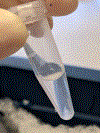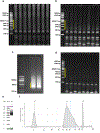Optimized single-nucleus transcriptional profiling by combinatorial indexing
- PMID: 36261634
- PMCID: PMC9839601
- DOI: 10.1038/s41596-022-00752-0
Optimized single-nucleus transcriptional profiling by combinatorial indexing
Abstract
Single-cell combinatorial indexing RNA sequencing (sci-RNA-seq) is a powerful method for recovering gene expression data from an exponentially scalable number of individual cells or nuclei. However, sci-RNA-seq is a complex protocol that has historically exhibited variable performance on different tissues, as well as lower sensitivity than alternative methods. Here, we report a simplified, optimized version of the sci-RNA-seq protocol with three rounds of split-pool indexing that is faster, more robust and more sensitive and has a higher yield than the original protocol, with reagent costs on the order of 1 cent per cell or less. The total hands-on time from nuclei isolation to final library preparation takes 2-3 d, depending on the number of samples sharing the experiment. The improvements also allow RNA profiling from tissues rich in RNases like older mouse embryos or adult tissues that were problematic for the original method. We showcase the optimized protocol via whole-organism analysis of an E16.5 mouse embryo, profiling ~380,000 nuclei in a single experiment. Finally, we introduce a 'Tiny-Sci' protocol for experiments in which input material is very limited.
© 2022. Springer Nature Limited.
Conflict of interest statement
Ethics declarations
Competing interests
J.S. is a scientific advisory board member, consultant and/or cofounder of Cajal Neuroscience, Guardant Health, Maze Therapeutics, Camp4 Therapeutics, Phase Genomics, Adaptive Biotechnologies and Scale Biosciences. C.T. is a founder of Scale Biosciences. All other authors have no competing interests.
Figures








References
Publication types
MeSH terms
Substances
Associated data
Grants and funding
LinkOut - more resources
Full Text Sources
Other Literature Sources
Molecular Biology Databases

